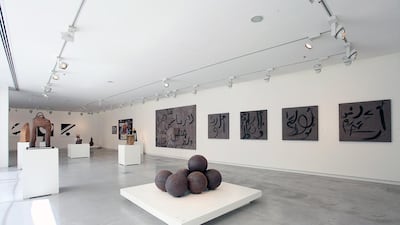In the courtyard at the Sharjah Art Foundation sit Abdel Wahab and Zhat El Himma.
The two large sculptures, both fired in the same kiln in Grasse, France, were created in 2006, inspired by the Arab epic (Sira) and embody those who withstand conflict and struggle. They serve as a metaphor for our times – and offer a first glimpse of Syrian artist Simone Fattal’s show at SAF.
Inside the building, two collages demand attention. Up close, the abstraction becomes clearer: the artwork reveals cut-outs of maps, from the break-up of the Ottoman Empire through to the present day, punctuated by images of artefacts and ancient sites from across the Arab world.
Fattal created Palmyra in 2014, two years before the city was destroyed by ISIL. In this 130x180- centimetre collage is a map of Syria that she had cut out of a newspaper 15 years ago.
“It’s very difficult, not only for me ... The killing of Syria is the greatest crime,” says Fattal. “It was already enormous to destroy Iraq. I want to witness, I want to speak, I want to talk. This collage is a very good contribution to the problem.”
Fattal had been creating collages since the late 1980s, particularly, she says, “in between spells of working in clay”. Twenty years later, they were shown in Paris for the first time (2015), and now in Sharjah.
“They speak like a journal,” says Fattal. “You put things together and make a statement and this is a collage for viewers to read every image.”
Or, perhaps, to read the multimedia artist’s mind, which is preoccupied with the themes of archaeology, the Arab world, landscapes and artefacts. All of these come through strongly in the exhibition, her first solo in the emirate.
“Since Simone’s participation in Sharjah Biennial 10, I have been fascinated by her work and envisioned curating an exhibition here in Sharjah,” says the show’s curator and SAF president, Sheikha Hoor Al Qasimi.
Though the exhibition features a healthy sampling of Fattal’s sculptures, it was her political collages that Sheikha Hoor felt “would provide the viewer insights into her practice as a sculptor”.
Besides Syria, Fattal is also concerned about endangered species. This preoccupation comes through in Palmyra, which features images of bison and elephants, as well as in some of her primordial sculptures, Lion and Wild Horse, both from 2008.
Though the exhibition space is rather crowded, the show does come across as a mini retrospective: while it presents recent works, it encapsulates themes and styles that Fattal has been practising for decades.
There is a good amount of text-based work inspired by Sufi poets, the Quran, the Hadith and mythology. On one wall is a series of paintings created on lava stone. A highlight is a 2006 diptych that features a verse from Jebu, a poem by the renowned Lebanese artist and poet Etel Adnan.
There also are two beautiful paintings from the late 1970s that depict Lebanon. Mount Sannine from 1978 features delicate swathes of pink, "the colour from the mountains just before sunset".
Though Fattal stopped painting for three decades, she picked up her brushes three years ago and created 35 black-and-white paintings, some of which hang on the wall opposite Mount Sannine. "They were a very urgent way of working – I painted one a day," she says of the abstract works that present a heavy geometry feel. "They were like drawings. I don't know what made me do it."
This is an important show, not least for its overt and concealed messages, but also because it pays tribute to an Arab modernist who deserves a salute.
“Our mission at the Foundation is to acknowledge artists who have continued to contribute greatly to our history of art,” says Sheikha Hoor. “Simone is a terrific example of someone who deserves both recognition of her accomplishments and a platform for continued creative expression.”
• Simone Fattal exhibition is at the Sharjah Art Foundation Art Spaces, Building F, until June 12. Visit www.sharjahart.org
artslife@thenational.ae

